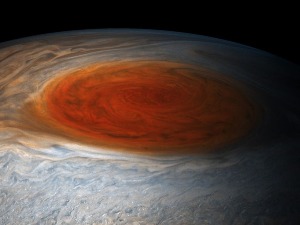
In a decade or two, the famous Great Red Spot (GRS) on Jupiter will not be as big as it is today.
The GRS is a superstorm on Jupiter that is larger than Earth. It has been active since the 1600’s. In comparison, the longest recorded storm here on Earth was Hurricane John, which lasted 31 days, from August 11 to September 10 of 1994.
Glenn Orton, a leading team member of the
Juno
Mission and a planetary scientist at NASA’s Jet Propulsion Laboratory, answered why Jupiter’s storms last so long in
Business Insider
.
“They don’t, at least not all of them,” he said. “Think of the GRS as a spinning wheel that keeps on spinning because it’s caught between two conveyor belts that are moving in opposite directions. The GRS is stable and long-lived because it’s ‘wedged’ between two jet streams that are moving in opposite directions,” Orton added.
Jupiter's jet streams can move faster than 300 miles per hour, which adds a lot of force to any storm spinning opposite to the planet’s rotation. The streams feed momentum into the vortex, Orton said.
Juno
will once again see the GRS in July and September of 2019, and again in December of 2020. Unfortunately, it will not fly as close to Earth as it did back in July of 2017.
“We're not planning currently ever to come as close without changing the orbit from its current configuration,” Orton said. “This also assumes that the GRS maintains its current drift rate in Jupiter’s atmosphere,” he added.
In contrast, storms on Earth do not last for hundreds of years. This is because, contrary to Jupiter, Earth’s surface is not wrapped in tens of thousands of miles of atmosphere. Our planet’s dynamic atmosphere is instead close to oceans and land. Earth is also small and spins more slowly than Jupiter, which spins once approximately every 10 hours. All of these factors make Earth’s jet streams disrupt weather systems and vortexes before storms can get too big.
“In truth, the GRS has been shrinking for a long time,” Orton said.
In the late 1800’s, the storm was as wide as 30 degrees longitude, or more than 35,000 miles. This is four times the diameter of Earth. In 1979, when
Voyager 2
flew by Jupiter, the storm had shrunk to twice the width of Earth. Now, it’s about 13 degrees wide in longitude and 1.3 times the size of Earth, Orton said.
In fact, the GRS doesn't have much time left.
“The GRS will in a decade or two become the GRC (Great Red Circle),” Orton said. “Maybe sometime after that the GRM (Great Red Memory),” he concluded.
[Source:
Business Insider
]

